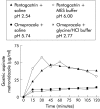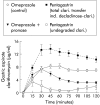Impact of acid secretion, gastritis, and mucus thickness on gastric transfer of antibiotics in rats
- PMID: 12235069
- PMCID: PMC1773392
- DOI: 10.1136/gut.51.4.490
Impact of acid secretion, gastritis, and mucus thickness on gastric transfer of antibiotics in rats
Abstract
Background and aims: The success of Helicobacter pylori eradication regimens depends on gastric pH, inflammation, and mucus thickness. Our aim was to investigate the effects of acid secretion, inflammation, and mucolysis on gastric antibiotic transfer.
Subjects and methods: A total of 134 anaesthetised rats were given metronidazole, amoxicillin, or clarithromycin intravenously and gastric contents were aspirated via an indwelling cannula. Acid secretion was controlled by either omeprazole or pentagastrin while gastritis was induced by infection with H pylori or dosing with iodoacetamide. Mucolysis was achieved by instilling pronase into the gastric lumen.
Results: Metronidazole transfer increased with acid secretion and fell with omeprazole, independently of gastric pH. Clarithromycin was also transferred with acid but was then rapidly degraded. Omeprazole prevented this degradation, raising gastric luminal concentrations. Omeprazole did not alter amoxicillin transfer. Gastritis induced by H pylori did not alter gastric transfer of metronidazole and amoxicillin but that of clarithromycin was increased by 23%. However, gastritis induced by iodoacetamide reduced clarithromycin transfer without any effect on metronidazole or amoxicillin transfer. Pronase treatment increased amoxicillin transfer fourfold and metronidazole by 66% but reduced clarithromycin transfer by 35%.
Conclusions: Metronidazole and clarithromycin are predominantly transferred with gastric acid rather than by an acid trapping mechanism. Pronase increases the appearance of amoxicillin and metronidazole in gastric secretions.
Figures




Comment in
-
Influence of antisecretory drugs on Helicobacter pylori eradication rates.Gut. 2004 Nov;53(11):1720; author reply 1720. Gut. 2004. PMID: 15479699 Free PMC article. No abstract available.
References
-
- De Koster E, Devaster J-M, Vandenborre C, et al. A nine years surveillance of Hp resistance to macrolides and imidazoles. Gastroenterology 1999;116(4 part 2):A145.
-
- Goddard AF. Getting to the route of Helicobacter pylori treatment. J Antimicrob Chemother 1998;42:1–3. - PubMed
-
- Lind T, Megraud F, Unge P, et al. The MACH2 study: role of omeprazole in eradication of Helicobacter pylori with 1-week triple therapies. Gastroenterology 1999;116:248–53. - PubMed
-
- Spiller RC. Is there any difference in Helicobacter pylori eradication rates in patients with active peptic ulcer, inactive peptic ulcer and functional dyspepsia? Eur J Gastro Hepatol 1999;11(suppl 2):S25–8. - PubMed
-
- Labenz J, Leverkus F, Börsch G. Omeprazole plus amoxicillin for cure of Helicobacter pylori infection. Factors influencing the treatment success. Scand J Gastroenterol 1994;29:1070–5. - PubMed
Publication types
MeSH terms
Substances
LinkOut - more resources
Full Text Sources
Other Literature Sources
